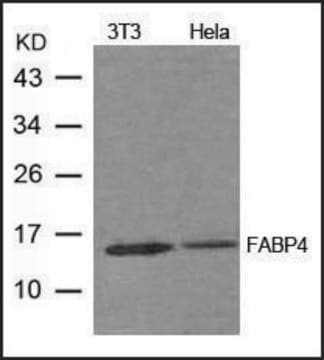AB5731
Anti-Nanog Antibody, NT
Chemicon®, from rabbit
Synonym(s):
Homeobox transcription factor Nanog, Nanog homeobox
About This Item
Recommended Products
biological source
rabbit
Quality Level
antibody form
affinity purified immunoglobulin
antibody product type
primary antibodies
clone
polyclonal
purified by
affinity chromatography
species reactivity
human, rat, mouse
packaging
antibody small pack of 25 μg
manufacturer/tradename
Chemicon®
technique(s)
western blot: suitable
input
sample type: mouse embryonic stem cell(s)
sample type induced pluripotent stem cell(s)
sample type: human embryonic stem cell(s)
isotype
IgG
NCBI accession no.
UniProt accession no.
shipped in
ambient
storage temp.
2-8°C
target post-translational modification
unmodified
Gene Information
human ... NANOG(79923)
mouse ... Nanog(71950)
Related Categories
General description
NANOG may be useful in the immunohistochemical diagnosis of tumors. NANOG is expressed in germ cells of the fetus and in some germ cell tumors of the gonads and central nervous system (CNS).
Specificity
Immunogen
Application
Stem Cell Research
Pluripotent & Early Differentiation
0.5-1.0 µg/mL. The antibody recognizes a protein of ~35 kDa on NT2/D1 cell lysate. Additional bands of ~55 and ~130 kDa may be seen depending on sample and antibody dilution used.Optimal working dilutions must be determined by the end user.
Quality
Western Blot Analysis:
1:500 dilution of this lot detected NANOG on 10 μg of Embryonic Mouse Brain lysates
Target description
Physical form
Storage and Stability
Analysis Note
Whole cell lysate from mouse embryonic stem cells.
Other Notes
Legal Information
Disclaimer
Not finding the right product?
Try our Product Selector Tool.
recommended
Certificates of Analysis (COA)
Search for Certificates of Analysis (COA) by entering the products Lot/Batch Number. Lot and Batch Numbers can be found on a product’s label following the words ‘Lot’ or ‘Batch’.
Already Own This Product?
Find documentation for the products that you have recently purchased in the Document Library.
Our team of scientists has experience in all areas of research including Life Science, Material Science, Chemical Synthesis, Chromatography, Analytical and many others.
Contact Technical Service








